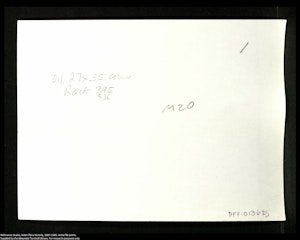Gretchen Albrecht (1943-)
Lagoon
1976
polychrome stain on canvas
1662 x 1775mm image
1700 x 1805mm frame
Collection of The Suter Te Aratoi o Whakatū, Nelson, New Zealand, purchased with the
assistance of the Queen Elizabeth II Arts Council, 1976
Accession no. 431
Reproduced with the kind permission of Gretchen Albrecht, January 2021
https://collection.thesuter.org.nz/objects/3/lagoon
Though nearly four times the size of Scales’s paintings, Albrecht’s Lagoon, 1976, was felicitously placed beside Scales’s Bry-sur-Marne, Orchard [BC069] in the exhibition Flora Scales at The Suter Te Aratoi o Whakatū, Nelson, New Zealand, 2018-2019.
In Scales’s painting the subtle shifts from deep to shallow space are contained within the framing edges of her canvas while Albrecht’s washes of liquid colour flow over her canvas to suggest a reaching and lengthening beyond the vertical borders. In both paintings the central, dark, strong, forked structure stabilises and gives a sense of structure to the flow and fluctuation of the space.
By linking the work of these two artists the curator demonstrates the chain of reference which continues artist to artist, age to age. As Scales said: “Everyone who looks is influenced…but you should forget that you’ve been influenced. How would I be painting if I’d never seen other work – I would be doing bullocks as in the caves in Spain.” (excerpt from The Notebooks of Marjorie de Lange recording conversations with Flora Scales, 1982-1983).
BC069
Bry-sur-Marne, Orchard
Landscape. Red brown vertical form, right of centre. Diagonal form from the bottom left of the vertical element, abraded and worked at. Oval pool of pale pink/white to left. Wavy shape of similar pale colours, between the vertical and scratched diagonal, which extends to upper margin of canvas. Blurred diagonal, lower right corner.
LL ochre brush point F Scales
Verso UR pencil (not in artist's hand) Bry-sur-Marne, Orchard (now covered by frame)
Verso Upper Centre label 336
Verso UL label artwork details
Verso UR label Alexander Turnbull Library
Verso Left Centre (not in artist's hand) pencil 395 30mm
Verso LL framers label
Verso LR framers label
Verso Lower Centre (not in artist's hand) pencil 395
Donated to the Alexander Turnbull Library, National Library of New Zealand by H. F. V. Scales, 1979
Framed with glass.
Alexander Turnbull Library, National Library of New Zealand
Wellington, New Zealand
Title and date supplied by artist at time of donation, 1979.
Alternative title, Orchard, Bry-sur-Marne, taken from the exhibition Flora Scales at The Suter Te Aratoi o Whakatū, Nelson, New Zealand, 2018, and Alexander Turnbull Library, National Library of New Zealand documentation.
Bry-sur-Marne is a commune in the eastern suburbs of Paris, France, 12.6 km from the city centre. In 1953, when Boris and Christiane Kalachnikoff built their house in Bry-sur-Marne, the population was approximately 6,660 and the town still retained its rural character.
Two black and white photographs of this work are included in an artist’s file dedicated to Flora Scales at the Alexander Turnbull Library, National Library of New Zealand, reference Scales, Helen Flora Victoria, 1887-1985, Artist file prints [see Related images 1-4]. The file contains black and white photographs on card of 26 of the artworks in the Alexander Turnbull collection and one not held in the collection [Untitled [Sand Dunes] [BC011]].
Each card measures 167 x 216mm and the image size varies. Each card has handwritten reference notes along the top detailing artist name, title, year, size, and reference number. Further, on the back of each card are handwritten annotations with information including media, reference numbers and location within the physical collection.
The cards in this file are undated. Correspondence B. de Lange and Kimberley Stephenson, Research Librarian Pictorial, Alexander Turnbull Library, September 2025, notes, “Neither the associated copy negatives nor the file prints are dated but based on notes I found in the negative register one group (intermittent between 1/2-092380-F and 1/2-092705-F) was in existence by May 1979, while a second group (intermittent between 1/2-162480-F to 1/2-162510-F) had been created by December 1986. Given most of the paintings entered the collection in 1979, this does suggest that the first group shows the works soon after they were accessioned. The second group appears to have been taken during reframing or conservation treatment as many are shown without their stretchers.” It is assumed that a card was made for this work at both dates, resulting in two copies noting similar information.
The central V-shape of the forked tree trunk is reminiscent of the ship's rigging seen in Scales's work of the 1920s [Shipping, Wellington Harbour] [BC128]]. It also brings to mind the agaves of the 1930s [Untitled [Mediterranean Scene] 1 [BC016]] and the derricks of the 1950s [Untitled [Mousehole Cornwall 2] [BC029]], in which this shape becomes a tool for her construction of dynamic pictorial space.
The V-shapes of the agaves, trees and derricks, significant elements in her work during and after the 1930s, begin to form the vocabulary of her Modernist work following Hans Hofmann's instruction to do away with single-point perspective.
As well as the equilibrium established by the balanced vanes of the V-shape, there is also an immanent sense of movement. Hofmann said, "We have to experience the object as vital in her existence in space" (Dickey, Tina, Color Creates Light: Studies with Hans Hofmann, Trillistar Books, Canada, 2011, pg 27). Hofmann explained that volumes revolve on their axes to create a sense of movement and counter-movement, which animates and gives depth to the flat surface of the picture plane.
Scales's use and manipulation of the V-shape is one of several examples in her work which demonstrate the way she assimilated, and made her own, the teachings of Hans Hofmann. This example in particular shows her personal interpretation, without imitation, of his theories about the creation of plastic space, which were crucial to the development of her modernism.




-1624056072.jpg?ixlib=js-3.8.0&auto=format&w=300)

